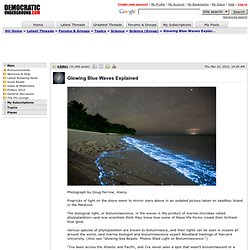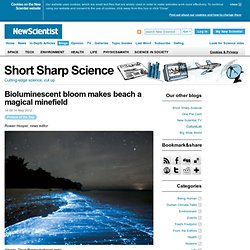

Glowing Blue Waves Explained. Photograph by Doug Perrine, Alamy Pinpricks of light on the shore seem to mirror stars above in an undated picture taken on Vaadhoo Island in the Maldives.

The biological light, or bioluminescence, in the waves is the product of marine microbes called phytoplankton—and now scientists think they know how some of these life-forms create their brilliant blue glow. Various species of phytoplankton are known to bioluminesce, and their lights can be seen in oceans all around the world, said marine biologist and bioluminescence expert Woodland Hastings of Harvard University. (Also see "Glowing Sea Beasts: Photos Shed Light on Bioluminescence. ") "I've been across the Atlantic and Pacific, and I've never seen a spot that wasn't bioluminescent or a night that couldn't be seen," Hastings said. more.
Mirrors to stars. Other names. Glowing Blue Waves Are Bioluminescence. Where you'll find it. Ancient Process. Eerie, glowing waves appear in Maldives, but don't panic. Sea Creatures. Natural. Watch surfers ride neon blue bioluminescent waves caused by red tide. Results. Chemical reactions. Gizmodo. Algae blooms. Deaths of Fish. Glowing Blue Waves Explained. Photograph by Doug Perrine, Alamy Pinpricks of light on the shore seem to mirror stars above in an undated picture taken on Vaadhoo Island in the Maldives.
The biological light, or bioluminescence, in the waves is the product of marine microbes called phytoplankton—and now scientists think they know how some of these life-forms create their brilliant blue glow. Various species of phytoplankton are known to bioluminesce, and their lights can be seen in oceans all around the world, said marine biologist and bioluminescence expert Woodland Hastings of Harvard University.
(Also see "Glowing Sea Beasts: Photos Shed Light on Bioluminescence. ") "I've been across the Atlantic and Pacific, and I've never seen a spot that wasn't bioluminescent or a night that [bioluminescence] couldn't be seen," Hastings said. The most common type of marine bioluminescence is generated by phytoplankton known as dinoflagellates. —Ker Than. Harmful Toxins. Phytoplankton. Pilots Advantage. Bigger Organisms. Non glowing Phytoplankton. How they Glow. Bioluminescent bloom makes beach a magical minefield. Rowan Hooper, news editor (Image: Doug Perrine/naturepl.com) IT DOESN'T get much better than this.

It's a moonless night and you are on a deserted beach in the Maldives. As the waves lap the shore, the beach lights up like Las Vegas. Glowing organisms stick to your feet. This picture was taken on Vaadhoo Island, but bioluminescing organisms are found all over the world. "Every so often, one of these bright specks of light would appear to take off and run up the beach," says photographer Doug Perrine. It doesn't work so well on the beach, but bioluminescence usually distracts predators by disrupting their swimming behaviour and preventing them from feeding. The light is produced by devilishly named twins: a pigment called luciferin and an enzyme, luciferase.
Predators. Bioluminescent Organisms.